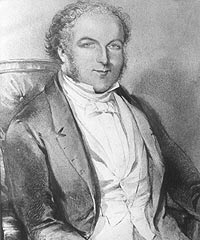On January 5, 1821 Fred became a member of the Royal College of Surgeons, receiving his diploma, London, for which he paid 11 pounds 10 shillings. In his father's will of 1824 he came into 1,000 from 3 percent South Sea stocks paid to him over the period 1824-26, as well as a sixth share of the antibilious pill business left to his father by Uncle George Dixon in 1821.
Always into geology, Fred, in 1823, was at Findon, on the Downs, involved in a dig for Roman funerary wares. By 1825 he was living at Great Coram Street, Russell Square, London, and married Maria Grant, daughter of the keepers of Grant's (the boarding house facility at Westminster School). Maria was an amateur artist of some talent and renown. They went to Egypt on their honeymoon, for a dig at Thebes, stopping first at Corfu to see Fred's brother William. It was on this trip that Maria painted a portrait of William's wife, Cecilia Pierina Gironci. It was also at this
In 1826 Fred and Maria bought land just off Chapel Road in Worthing. Actually Maria's father bought it (he would deed it over to Fred on March 21, 1833), and Fred built the house that would become the well-known Worthing landmark
|
Fred's life in the 1820s consisted of doctoring, fossiling, music, traveling, socializing, and civic duties for the town of Worthing. Given his tremendously affable nature and enormous talents he was a boon to the town, and rapidly rose to become one of its dignitaries.
At a public meeting in Worthing, on August 20, 1829, with the Rev. Henry Dixon as chairman, it was agreed to create, by subscription, a dispensary in town [the Worthing Dispensary or Ann Street dispensary, as it was also known, was the forerunner of Worthing Hospital]. Fred was, aside from being the instigator of this, one of the two surgeons, and Rev. Henry was treasurer. In 1831 541 patients were treated here.
